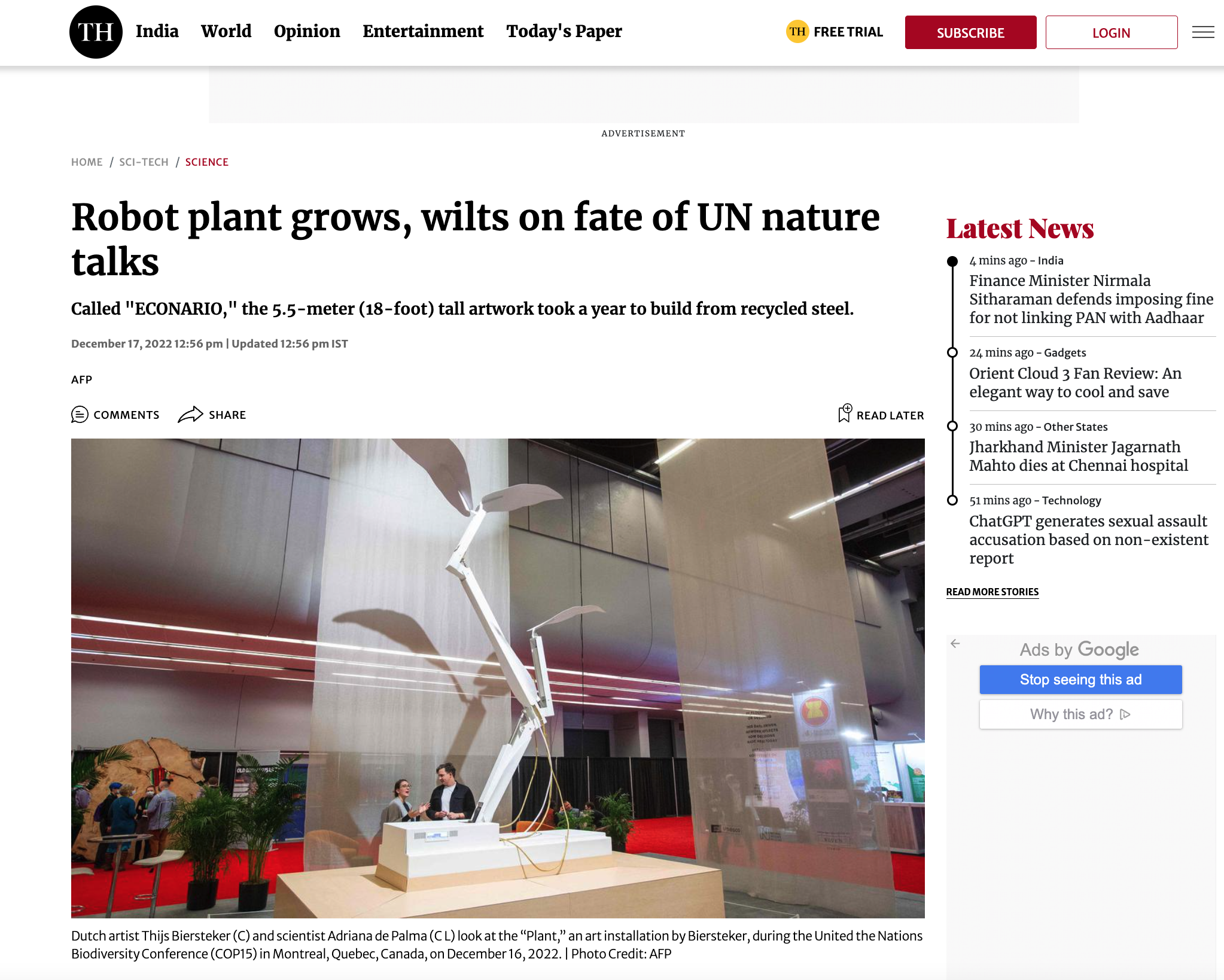ECONARIO
AT UN COP15, 2022
Visualising in real-time the impact of the conference’s key decisions on biodiversity as they’re being negotiated.
In collaboration with the Natural History Museum (UK) X UNESCO x LVMH
At the 2022 COP15 UN Biodiversity conference, Econario, visualised the impact of key decisions in real-time. People from the IISD -ENB where in the negotiation rooms sending their findings to a team of scientists.
Scientists from the Natural History Museum in London then calculated these impacts using the Biodiversity Intactness Index.
In real-time the data was uploaded and Econario's movements, flourishing or withering, represented the consequences of conference decisions.
This innovative scientific real time visualisation highlighted the significance of informed choices for the future of our planet.
providing a thermometer of the conference’s progress
for policy makers, journalists and enviromental specialists.
During the 2022 COP15 UN Biodiversity conference, a significant artwork named
Econario offered a unique data visualization of real-time decisions influencing sustainability and scientific outcomes.
This dynamic representation was made possible through a collaborative effort between the Natural History Museum in London and the artist studio. The scientists involved utilized a wealth of data from the Biodiversity Intactness Index (BII) and the PREDICTS database, which boasts over 4.9 million data points from more than 100 countries.
The sophisticated, 5.3-meter animated sculpture, Econario, provided an engaging form of scientific visualization for conference attendees, decision-makers, and heads of state. The movements of this robotic plantanoid - either flourishing or withering - vividly reflected the impact of the conference decisions on global biodiversity.
This innovative integration of data into Econario underscores the emerging communication strategies in scientific visualization, a crucial aspect in bridging the gap between complex data and governmental decision-making. The artwork serves as a compelling tool to raise environmental awareness, underlining the impact of our decisions on global biodiversity and the significance of improved data and metrics in monitoring progress
“I am blown away by this piece. The numbers around biodiversity loss are cold hard facts, but cold hard facts never grabbed anyone by the heart. With ‘Econario’, you feel joy when it grows and becomes more natural; and you feel pain when it wilts. It has soul. And it really brings home what’s at stake.”
Incorporating real-time data from the BII, the collaboration between the artist studio and the scientific institution illustrates sustainable practices in action. The BII amalgamates data on ecosystems and species populations with data on anthropogenic pressures, such as land use, to estimate biodiversity loss. This metric aims to ensure key conference commitments are backed by comprehensive biodiversity data and metrics.
““Strengthening the dialogue between science and culture is at the heart of the UNESCO mandate. Econario artistic work based on scientific data allows everyone to see the tangible commitments of the Parties for biodiversity. We hope it can raise the need for urgent action to conserve the living fabric of life that we all depend on”
”
Econario is a testament to the evolving methods of scientific visualization, bridging the gap between complex scientific data and public understanding. As Audrey Azoulay, Director-General of UNESCO, aptly noted, "This powerful installation translates complex scientific data into a simple, yet profound message regarding the immediate impact of decisions made on our environment." The partnership between the scientific institution and artist studio epitomizes sustainable practices, emphasizing the necessity of responsible and informed choices for our planet's future.
Data partner
Natural History Museum (UK)
Supported at COP15 By
Artist
Thijs Biersteker
Scientific Lead
Prof Andy Purvis and Dr Adriana De Palma
Sustainably created at
Woven Studio
Studio Director
Sophie de Krom
Technical engineer
Tom Bekkers
Technical build
Bastiaan Kennedy, Sander van Gelder
Technical development
Jochem Esser, JBS Technics
Frontend developer
Bas van Oerle, Thijs Biersteker
Thanks to
The Natural History Museum London, Sara Contu, Kunstkerk Dordrecht, Boris Gunst, Nathan Pottier, Madelief Broekman, Dennis van der Sluijs
Credits film/photography
Director: Jerom Fischer
DP: Thomas Fibbe
AC: Harvey Pieper
Grading: Jan Maarten de Wit
Sound: End of Time
Photography: Thijs Biersteker, Jerome Fischer, Cas Kerrsens
Keynote at the COP15 by Artist Thijs biersteker.
Next to showing the artwork at the confreence the artist took the stage at the UN conference to deliver a keynote talk about the importance of art in science communication. His talk got noticed by the UN making it Quote of day of the whole Conference.
Mr. Thijs Biersteker, eco-artist
See the whole keynote below :
Econario is an artwork normally shown in museums arround the world , lear more about it here













